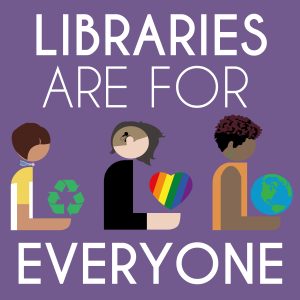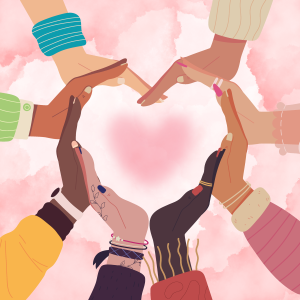Inspiration Report: Imagination Station
Taking the Time to Learn: Reflection on Infinite Learning

I love the idea of Infinite Learning. I have always believed that there is always something to learn. I have taken this concept into my career working in libraries always seeking out ways to learn a new skill or a professional development opportunity and I plan to always carry it with me to continue my growth in the information professional field. I have worked at my library for ten years and whenever I train anyone one of the first things I tell them is this: just when you think you know or have seen everything, something will come along that you don’t know or haven’t seen before. It still happens to me all the time and I enjoy it because it gives me the opportunity to learn something new.
I despise the saying, “that’s the way we’ve always done it.” It is stagnation. It does not allow for growth or learning or adapting. Which is everything that the modern library should be. We live in a very different world than five years ago, so why would we want to continue to run the library as we did back then or before then? People are different, this means the community as well as staff. As the community changes, we must adapt with it to evolve the library to meet the needs of the people we serve. Services shouldn’t always be the same and we should be taking the time to access what is working and what is no longer working for the community.
Stephens (2014) writes “librarians should seek every opportunity to be teachers in their communities.” I resonate with this idea because it means that as librarians we need to be learning all that we can so that we are able to help and teach the community new technologies, new concepts, and building stronger connections through our interactions. Without libraries there wouldn’t be many other opportunities for people to learn new things and connect with people in doing so. As we learn new things, especially when it comes to technology, then we are able to bring it into the library to grow the space and ensuring that it remains a place for learning, therefore building a place to adapt for the future instead of staying in the past.
Reference
Stephens, M., (2014). Making the case for the library as space for infinite learning [pdf]. YLibrary?.
Building Empathy Through Stories: Reflection on the Power of Stories
One of the most interesting things about working in libraries is the fact that we get to see such a wide variety of people with different backgrounds, statuses, cultures, etc. It allows us to interact with people in ways that we may never get another chance to. We get to hear so many different stories from people, and although we don’t always have the time to appreciate them in the moment, they have a way of sticking with us.
I could be helping someone with the smallest task, such as helping them copy paperwork, and the person will dive into why they need to do this task and a lot of the times the reason is not a happy one. Which is why I believe working in the library helps to build empathy, if you let it.
People love to share their stories. It doesn’t matter if you are a perfect stranger, and sometimes that’s even better, because you are just going to listen without judgement. Now I understand it could be burdensome. We often don’t have time when we have other tasks that we trying to get done while also helping patrons. But listening to people’s stories can help put some perspective on our own lives. Sometimes we can get so caught up in what we are doing we forget what others are going through. Many people, when faced with difficulties, turn to frustration and anger quickly. Taking the time to listen to these people’s stories or at least be open to can help to deescalate tensions and frustrations, it is allowing empathy to guide our work.

I have always been interested in the idea of the Human Library. Although a lot of the information you can find about marginalized communities you can find in books, but actually being able to speak to a person and “check them out” as one would a book to read give access directly to the source. It allows for actual interaction with the source. With so much dissension in the world, there are so many people that could benefit from a service like this. It wouldn’t get everyone to change, but many people are working from a bases of what they hear online and from others because of their limited worldview that they don’t know anyone different.
As librarians, it is important to keep this in mind and approach helping library users with an open mind when we hear these stories because they are coming from people who are going to be vastly different from us. It helps us to get to know the community we serve better but it could help us to be more caring and compassionate with all different types of people.
Wentz, E., (26 April, 2013). The human library: Sharing the community with itself. Public Libraries Online. https://publiclibrariesonline.org/2013/04/human_librar/
ChatGPT the New Wikipedia? – Reflection on New Horizons

I remember when Wikipedia first came out, it was a big no-no to use it for anything. Although it was so tempting to use because it had so much information in one place. But it was open for anyone to change, so there was no guarantee that the information was going to be accurate. Even with the sources that are provided there was still a lot of distrust over the accuracy of the information retrieved from the site, so all through school we were warned to stay away from it when completing assignments.
I still thought this was the general consensus until after starting the MLIS program when I started seeing professors using Wikipedia as sources. I have had classes where we had to search for information on Wikipedia and discuss the accuracy and the merits of using it as a source of information. And I can see why this would be important because Wikipedia is every where now. A lot more so then back when I was in high school or doing my undergrad school work. Fister, et al (2023) writes, “Wikipedia results started popping up as answers on the first page of Google searches. Having a Wikipedia page became a status symbol for many.” So now it’s become more acceptable to use Wikipedia as a source of information because of its “status symbol” of legitimacy. You still need to check the accuracy of the information retrieved but the inclusion of sources and other tools make it possible.
Fister, et al. raises some interesting points in this “panic” now being transferred to Generative AI, like ChatGPT. There are a lot of concerns with AI, which is understandable, and should not be ignored. But just as the panic set in with Wikipedia in its early days while there were glitches and some concern over the accuracy of the information, it is still the early days of AI.
There is a lot more work that has to go into AI before the panic can subside because there is so much more at stake. Creating more environmentally friendly models and being able to ensure the accuracy of information is going to be high on that list of to dos. When the AI can hallucinate answers it should give anyone pause as to the information taken from an AI tool, but this is not always known be the people using it, such as students using it to do their homework assignments. It is being integrated more and more into our every day online lives and it is important to remain cautious but it is important as information professional to understand how to use it because it is exactly what the foundation of our jobs is, a source of information, and we need to know how to navigate it to help others navigate it correctly.
Fister, B., & Head, A. J. (4 May, 2023). Getting a grip on ChatGPT. Inside Higher Ed. https://www.insidehighered.com/opinion/views/2023/05/04/chatgpt-reshaping-information-infrastructures-opinion
Innovation Roadmap: Ask a Librarian Live
AI in Libraries – Reflection on Hyperlinked Environments

There is a lot of animosity towards AI and the future. There is a lot of unknown when it comes to its potential and what it is going to mean for jobs, creativity, and critical thinking. When it just came out I didn’t know anything about it. It just felt like one day everyone was talking about it, so I was exposed to it much later. I started exploring it in little ways by asking it to help me create creative names for our craft programs in our library. At the time I didn’t know anything about how to query to get the results I wanted but I liked that it gave me inspiration to then form my own title by mixing them together or changing them a bit to make titles that I liked better.
As I’ve gone through the MLIS program, I have had the opportunity to explore using AI more. I think there are definitely a lot of concerns over the technology that are valid, but as it is still in its early days I think there is a lot of growth that can happen and a lot of potential that it could be very useful. If used correctly…
As I read the article, “Four Reasons to be Optimistic About AI’s Energy Usage”, I felt a bit more hopeful in the future of AI, especially when it comes to the environmental impact that it can have. We all know that technology isn’t going anywhere. It has become too embedded in our every day lives for that and there are going to be ways to make things more efficient. I liked the idea of the small AI models that would make the cooling more energy efficient and have them run through people’s personal devices, as that is where most people access their technology from would be the most efficient.
Technology moves fast and it’s not always where it needs to be before it starts being widely used, which is why I think it is good to still be cautious about using it. I do think it has a lot of potential and that it is important as information professionals to start learning more about it to be able to help with the hiccups that library users can run into so that we are able to provide information about it, especially when it comes to using it as an information source.
Heaven, W. D., (20 May, 2025). Four reasons to be optimistic about AI’s energy use. MIT Technology Review. https://www.technologyreview.com/2025/05/20/1116337/ai-energy-use-optimism/
Mind Matters, (18 December, 2022). Why we should not trust chatbots as sources of information. https://mindmatters.ai/2022/12/why-we-should-not-trust-chatbots-as-sources-of-information/
Inclusion in Libraries – Reflection on Hyperlinked Communities

The idea of inclusion in libraries has really hit home with me this week. After reading “Do You Want to Dance? Inclusion and Belonging in Libraries and Beyond” by Christian Lauersen, I reflected on the idea that everyone agrees with inclusion in library, but there are hidden biases that can make us sometimes unconsciously hyper vigilant against individuals or groups of people.
I have witnessed this especially with unhoused individuals. They come into the library with a backpack or bags of their belongings. My library does not have an official policy on what they can bring in but I know some libraries limit the amount of bags as they can block walkways and present hazards. When they enter the building, it is like a trigger, I have seen staff and patrons both go on high alert like they are already convinced that they are going to cause a problem. When really they are there just like anyone else.
Libraries are supposed to provide safe spaces for the community and of course no one wants to have any issues but it’s like they want to act first to prevent any issue happening by giving into that hidden bias that there is a potential for an issue to arise before one does. This hyper vigilance includes watching them more closely than any of the other patrons as well as assuming they are in need and step in to get them help without them asking for it. No one really says they should not be in the library but there seems like there is more awareness around their presence than any other patron. They basically have to prove that they aren’t going to cause a problem over a period of time of being in the library before people start to calm down and pay them no additional attention. And to me it doesn’t sound very inclusive.
So this article had me thinking about how libraries can be more inclusive to unhoused individuals? With the state of the world right now there, I wouldn’t doubt that there will be an increase over time and they are going to need places to go just to be out of the heat or the cold.
One of my favorite points made by Lauersen was “diversity is being invited to the party. Inclusion is being asked to dance”. And I think this is great way to think about the difference between the two concepts we must embrace as library professionals. Because I think it’s about making people feel comfortable and welcome in the space. Even though everyone is invited it’s important to make them feel like they are wanted there and not just tolerating their presence.
Lauersen, C., (2018). Do you want to dance? Inclusion and belonging in libraries and beyond. The Library Lab. https://christianlauersen.net/2018/06/07/inclusion-and-belonging-in-libraries-and-beyond/
Humans at the Heart of the Library: Assignment X Participatory Services in Libraries
Libraries are no longer spaces where you only go to read or do homework, working in silence and being deathstared at if you had a squeaky shoe . Instead they have become places of retreat, co-working, and connection.

Despite the increased use of technology in library services, there continues to be a need for humans to remain at the heart of libraries. This does not just mean the librarians and the library worker, but also the communities in which they serve. Participatory Services allows for the community to be heard and engaged with by the library.
Michael Casey (2011) writes, “[t]he participatory library engages and queries its entire community and seeks to integrate them into the structure of change.” This is a reiteration from his 2007 book Library 2.0: A Guide to Participatory Services. This idea caught my attention because having worked in a public library for the last ten years and seen a lot of ups and downs with patrons, therefore this idea can be a little intimidating to put into practice. But as libraries are meant to serve the community, participatory services are fundamental to understanding the needs of the people.
The challenge I have encountered with this idea has been the expectation that a change will happen and it should happen right away. There have been many times suggestions have been placed that are not a possibility for any number of reasons. We have had a suggestion made multiple times that we completely relocate computers so they would not distract their child from checking out books. Although we try to accommodate the suggestions that are within our control, these unattainable suggestions and requests tend to dominate the conversation. A question, therefore, I would like to pose is how do libraries continue to integrate the entire community and avoid becoming jaded and dismissive when unable to provide a solution that would satisfy those who pose an unattainable suggestion?
With that said, l believe that it is fundamental that libraries engage in participatory services. Stephens (2016) writes, “[b]reaking down barriers remains a goal for us all.” By inviting the community to engage with the services this allows for barriers to be stripped away and for the user to become part of the library instead of just a transaction. This helps to build empathy and humanize that community that is being served.

This is why I want to embrace participatory services as I continue to grow in my career in libraries. I want to explore different ways to engage with the community and break down the barriers between library services and the people. I am interested in the idea of creating a blog for the community to read. This would be a good way to share information and updates about the library, but also a way to invite users to also share and create a dialogue with librarians and other library workers as there is not always a lot of time to engage in a conversation.
Participatory services is a forever evolving task that requires commitment. The needs of the community change over time and therefore it is important to be able to adapt with them and keep libraries moving forward into the future with humans at the heart.
References
Casey, M., & Savastinuk, L.C., (2007). Library 2.0: A guide to participatory library service. Information Today, Inc.
Stephens, M., (2016). The heart of librarianship: Attentive, positive, and purposeful change. ALA Editions.
Stephens, M., (2019). Wholehearted librarianship: Finding hope, inspiration, and balance. ALA Editions.
Tame the Web, (20 October, 2011). Revisiting participatory service in trying times — A TTW guest post by Michael Casey. https://tametheweb.com/2011/10/20/revisiting-participatory-service-in-trying-times-a-ttw-guest-post-by-michael-casey/
Introduction
Hello all,
Welcome to my Introduction post for INFO 287 – The Hyperlinked Library. My name is Kelli. I’m from Murrieta, CA. I work in a public library as a Youth Services Supervisor. I just had my 10 year anniversary at the library. Over those 10 years I have worked in the Circulation department, Reference department, and now the Children’s department. This is my last semester of the MLIS program. I am excited to finish and explore new opportunities with my degree. I choose this course because I am interested in the future of technology within the library universe and look forward to exploring more throughout the semester.
Here is a picture of me with some performers we had for our Summer Reading program this past summer and a picture of a bobcat that recently visited the library.

